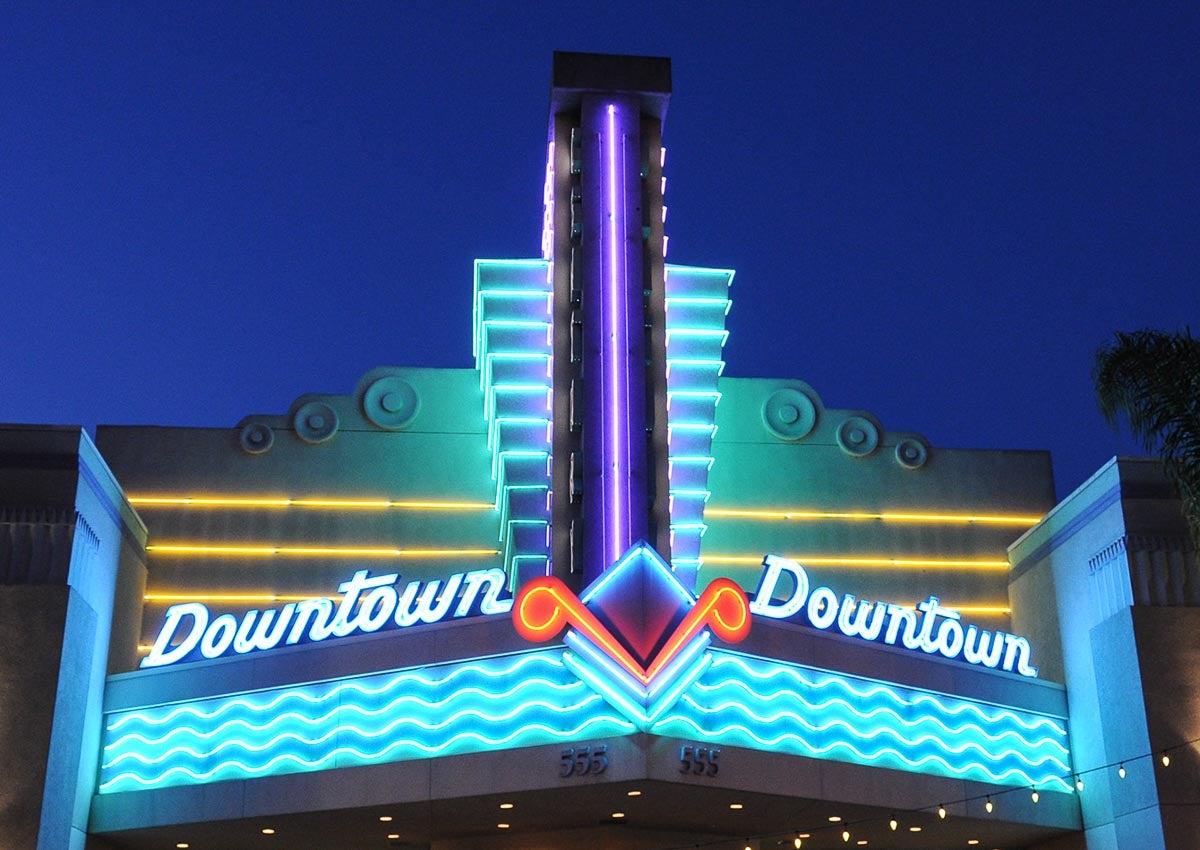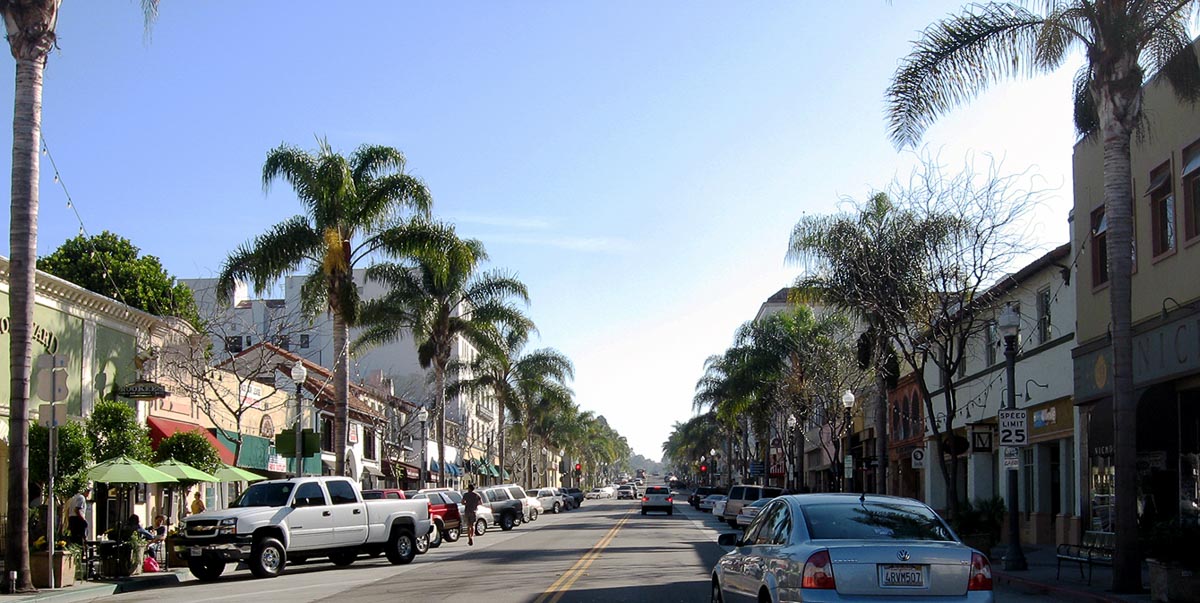My favorite street is closed to cars at the moment. But not to people. And that’s just fine with me.
Recently, amid the COVID-19 pandemic, the City Council in Ventura, California, extended what is technically known as the “Temporary Outdoor Business Expansion Program” — more popularly known as “Main Street Moves.” Simply put, because indoor dining is still prohibited in California, Main Street in downtown Ventura has been blocked off to cars so that restaurants can put tables out on the street.
Main Street Moves is a whopping success. And it shows what makes a truly great street: It’s flexible, able to bend to the demands of the moment, rather than rigidly serving one purpose at all times.
I have driven Main Street thousands of times. I have also walked, biked and ridden a bus along it more times than I can count.
Along Main Street, I’ve also lit Christmas trees, twirled in fake snow, eaten tornado potatoes, accompanied the police as they sorted out a marital dispute, shot the breeze with homeless people (just part of the mayor’s job), gotten into an argument with angry Tea Partiers over the constitutionality of the parking meters, watched my bleary-eyed daughter walk to middle school with a giant Starbucks cup in her hand, dined on just about every type of food you can imagine, gotten into more than one fight with a girlfriend, ridden in a dozen or so parades, observed the police chief having a friendly conversation with the head of the local Hells Angels charter, sat in on an Italian class at a sidewalk café that gradually turned into a discussion group about politics … and also just lived for a while in a big blue Victorian on Main Street.
Through all of these experiences — much more than through the thousands of times I have driven down the street — Main Street in downtown Ventura has become a part of me. Partly, of course, this is an emotional connection that was established over 25 years of participating in life in Ventura. But mostly it’s because of the fact that Main Street is used not just for cars but to help people actually live — and celebrate — life.

There’s a big debate in urban planning these days about what streets are for. Are they simply to move cars, which is how most people travel, as fast as possible? Or are they meant to serve a variety of purposes: Moving pedestrians, bicyclists and people on public transit and acting as a kind of backdrop for life — which, of course, requires that the cars be slowed down or, in some cases, even removed. Not long ago, San Francisco removed all cars from Market Street, as New York did on 14th Street. The result was a lot of controversy, but no “carmageddon,” as many predicted.
The answer to the question of what a street is for, of course, is that it depends. Under ordinary circumstances, you can use Main Street in downtown Ventura to actually drive from one place to another, though you’ll be going pretty slow and it’ll probably take you a while. If you want to get somewhere in a hurry, there are alternatives, including the Highway 101 freeway three blocks away. But as my friend Roger Millar, now Secretary of Transportation in Washington State, likes to say: “If you don’t want traffic engineers to flatten your town in order to move cars, they have to think of it as a destination, not a place people pass through.”
That’s what makes Main Street my favorite street: It’s a destination — a place people go.
The key to making Main Street a destination is flexibility — the ability to speed the traffic up, slow it down, or even just close it to traffic altogether so that the street can serve the community’s needs of the moment. And it’s this flexibility — using the street differently in different situations for different purposes — that provides the opportunity to create a variety of different experiences.
Just one example: More than a decade ago, Main Street was shut down for the premiere of Kevin Costner’s (admittedly not-well-remembered) movie Swing Vote, complete with a red carpet running across it. Later, Costner’s band played a concert on a stage set up on at Main and California streets — downtown’s “100% corner” — with the California Street hill that leads up to City Hall serving as a natural amphitheater. (Costner counts Ventura as his hometown and returned to Main Street a decade later to participate in a benefit concert for victims of the Thomas Fire.)

But the Costner concert wasn’t an aberration. Several times a year, Main Street is shut down for parades and street fairs, which is part of the reason why Main Street Moves was implemented without much resistance. There’s something about closing a downtown street to traffic that’s magical. Downtowns are usually dense places, with buildings close to the street. This urban structure crowds people closer together, whether they are watching a parade, dancing at a concert or strolling among booths at a street fair. Closing a wide suburban street to traffic just isn’t the same.
Of course, closing a street to traffic also allows you to introduce a bit of whimsy that isn’t usually possible when cars are whizzing by. Consider the story of Sham Hock, a giant inflatable green pig whose life and tragic demise are inextricably linked to Main Street.
For many years, Hock had been one of the highlights of Ventura’s annual St. Patrick’s Day Parade along Main Street, his inflated smile winning the hearts of everyone along the parade route. During the parade in 2017, to the dismay of his fans, Hock deflated in front of the judging table on Main Street, right near the library. A few months later, Ventura’s civic leaders led a funeral parade down Main Street to honor him.
But a great street doesn’t have to be closed to traffic to be great — as long as it’s designed for people as well as cars. Main Street in downtown Ventura is wide, but there’s diagonal parking along the sides, so only one driving lane in each direction. The locals know to drive slow.
And in most places, the sidewalk is actually wider than the driving lane — about twice as wide as the typical sidewalk. You can walk hand-in-hand, and people coming the other way can still pass you. Unlike most streets in America, Main Street is designed so that you feel like you belong there if you’re walking on foot.
Partly for this reason, Main Street has always felt almost as if it’s part of my house — my front hallway, connecting me to the world. This was especially true in the years that I lived in the big blue Victorian — but I also felt it during the 14 years that I had an office downtown and lived elsewhere in Ventura.
I would often go three or four days during the week without getting in my car, while I used Main Street as a lifeline to everything I needed: restaurants, stores, City Hall, the library, the bank, my office. All were within three or four blocks of where I lived and most were along Main Street.
And especially during the years when I was in politics, I’d constantly bump into people I needed to talk to at some point along Main Street — everyone from the city manager and prominent business owners, down to ordinary folks who would stop me and give me hell, which I sometimes deserved.
We usually think of this kind of lifestyle as something only available to people who live in large cities. After all, most of us live most of our lives buckled into cars, driving around auto-bound suburbs. But a great street like Ventura’s Main Street can create this experience in a city of any size.
Indeed, the small-town urbanism that Main Street brings to Ventura even made me a better parent — especially after I got divorced when my daughter was an adolescent.
In “A Better Place To Live,” Philip Langdon recalls that while growing up in a small but walkable town in upstate New York in the 1950s, he didn’t have the typical American experience of being chauffeured around until he was 16, and then suddenly being thrown the car keys. Rather, because he could walk and bike on his own from a young age, he was able to expand his world little by little, exploring farther and farther away from home as he got older — a much richer and healthier childhood experience.
Because Main Street is a great street, my daughter — growing up in the 2000s — was able to have the same kind of experience. From adolescence she walked to stores to buy gifts for her friends, Starbucks to drink coffee and people-watch, the movie theater with her friends, the park to play with her dog, and even her mother’s office — all of which were within walking distance on Main Street.
She often felt cooped up in the Victorian, which didn’t have a yard. She begged me to let her jog, even after dark. Finally, I agreed to let her go jogging, but only if she stayed on Main Street between the house and Mission San Buenaventura — knowing that two beloved Main Street business owners, Clary Rudd of Bank of Books and Chang Liampetchakul of Tipps Thai, were always watching the street. They’d see her go in one direction and look out to make sure she came back.
In part, I suppose, that’s just small-town America. But my daughter wouldn’t have had the same experience even in a small-town suburb. The qualities that make Main Street a great street played a critical role in her growing up into the woman she is today.
Main Street actually does go somewhere. All in all, it is 6 miles long, connecting Highway 101, just west of downtown, to another section of 101 in East Ventura. Along its course, it flows through different kinds of neighborhoods — not just downtown Ventura but the pre-war commercial strip of midtown, alongside Ventura High School, the city’s pioneer cemetery and Community Memorial Hospital; past Pacific View Mall; underneath a different freeway (Highway 126); and finally through a congested suburban shopping zone that includes a Target and other stores. Down that way, it serves as a street that exclusively moves cars, though, because of the congestion, they don’t go very fast on that stretch of Main Street either.
But that doesn’t take anything away from the qualities that make it my favorite street. I don’t know if Main Street Moves will be permanent, though it will continue to “flex” between being open and closed to cars depending on the situation. In that regard, I think Ventura can use Main Street to lead the way in the post-pandemic world, where our “built environment” must be flexible and adaptable, rather than rigid. In a world flooded with SUVs and pickups, that’s quite an accomplishment.
This essay originally was published on Medium.

